Antibody data
- Antibody Data
- Antigen structure
- References [1]
- Comments [0]
- Validations
- Western blot [1]
- Immunocytochemistry [3]
- Other assay [3]
Submit
Validation data
Reference
Comment
Report error
- Product number
- PA5-21989 - Provider product page

- Provider
- Invitrogen Antibodies
- Product name
- TNNI3K Polyclonal Antibody
- Antibody type
- Polyclonal
- Antigen
- Recombinant full-length protein
- Description
- Recommended positive controls: 293T, A431, H1299, HeLaS3, HepG2, Raji. Predicted reactivity: Mouse (93%), Rat (93%), Zebrafish (83%), Dog (97%), Rabbit (97%), Chicken (90%), Rhesus Monkey (97%), Chimpanzee (99%), Bovine (98%). Store product as a concentrated solution. Centrifuge briefly prior to opening the vial.
- Reactivity
- Human
- Host
- Rabbit
- Isotype
- IgG
- Vial size
- 100 μL
- Concentration
- 1 mg/mL
- Storage
- Store at 4°C short term. For long term storage, store at -20°C, avoiding freeze/thaw cycles.
Submitted references Tnni3k alleles influence ventricular mononuclear diploid cardiomyocyte frequency.
Gan P, Patterson M, Velasquez A, Wang K, Tian D, Windle JJ, Tao G, Judge DP, Makita T, Park TJ, Sucov HM
PLoS genetics 2019 Oct;15(10):e1008354
PLoS genetics 2019 Oct;15(10):e1008354
No comments: Submit comment
Supportive validation
- Submitted by
- Invitrogen Antibodies (provider)
- Main image
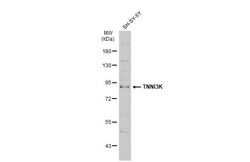
- Experimental details
- Western Blot using TNNI3K Polyclonal Antibody (Product # PA5-21989). Whole cell extract (30 µg) was separated by 7.5% SDS-PAGE, and the membrane was blotted with TNNI3K Polyclonal Antibody (Product # PA5-21989) diluted at 1:5,000. The HRP-conjugated anti-rabbit IgG antibody was used to detect the primary antibody, and the signal was developed with Trident ECL plus-Enhanced.
Supportive validation
- Submitted by
- Invitrogen Antibodies (provider)
- Main image
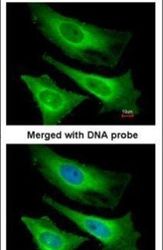
- Experimental details
- Immunofluorescent analysis of TNNI3K in paraformaldehyde-fixed HeLa cells using a TNNI3K polyclonal antibody (Product # PA5-21989) at a 1:200 dilution.
- Submitted by
- Invitrogen Antibodies (provider)
- Main image
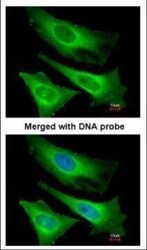
- Experimental details
- Immunofluorescence analysis of paraformaldehyde-fixed HeLa, using TNNI3K (Product # PA5-21989) antibody at 1:200 dilution.
- Submitted by
- Invitrogen Antibodies (provider)
- Main image
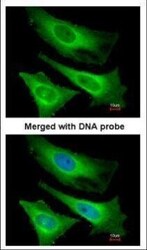
- Experimental details
- Immunofluorescence analysis of paraformaldehyde-fixed HeLa, using TNNI3K (Product # PA5-21989) antibody at 1:200 dilution.
Supportive validation
- Submitted by
- Invitrogen Antibodies (provider)
- Main image

- Experimental details
- Fig 2 The Tnni3k gene in naked mole-rats ( H . glaber ). A. Genomic DNA sequence at the end of intron 15 and beginning of exon 16 and deduced protein coding sequence (in 1 letter code above) in mouse (Mmu) and in H . glaber (Hgla). The in-frame premature stop codon is indicated in red type, and lies at position 22288559-561 (reverse complement) of NW_004624742.1 and at 1144837-839 (reverse complement) of NW_004629930.1. The sequence trace confirms the accuracy of the H . glaber genomic sequence. B. Western blot to detect Tnni3k; the blot contains ventricular protein from one wild-type (WT) C57BL/6 mouse, one homozygous (-/-) mouse, and two individual H . glaber animals. C. Ventricular mononuclear CM% in adult hearts of two inbred mouse strains (SJL/J and A/J), which represent the lowest and highest known values of mononuclear CM% among common inbred strains, and in adult H . glaber . Data for SJL/J and A/J mice are from our previous evaluation [ 20 ] and are shown here for reference. D. Evaluation of nuclear ploidy in single cell preparations from one C57BL/6J mouse (at left) and four naked mole-rats, as measured by DAPI fluorescence. Values shown represent fluorescence intensity per nucleus from mono- and bi-nucleated cardiomyocytes and endothelial cells, normalized to the median intensity of endothelial cell nuclei; a normalized value of 1.0 is assumed to be the median signal from a diploid nucleus. Each dot is one measured nucleus. Numerical quantitations of 2N and >=
- Submitted by
- Invitrogen Antibodies (provider)
- Main image
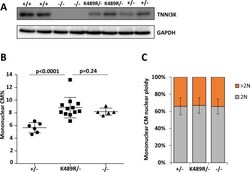
- Experimental details
- Fig 3 Consequences of a kinase-dead Tnni3k allele in mice. A. Western blot of Tnni3k protein from mice of the indicated genotypes, demonstrating that the K489R protein is stable in vivo. B. Ventricular mononuclear CM% in mice of the indicated Tnni3k genotypes; heterozygous (+/-) and (-/-) mice were littermates of the K489R/- mice, but not of each other. C. Evaluation of nuclear ploidy specifically in the mononuclear CM subpopulation of mice of the indicated Tnni3k genotypes. See also S4 Fig .
- Submitted by
- Invitrogen Antibodies (provider)
- Main image
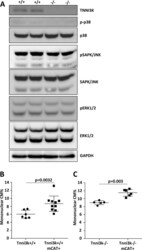
- Experimental details
- Fig 5 Tnni3k converges with oxidative stress. A. Western blot of ventricular protein from two wild-type and two Tnni3k P3 mice showing phosphorylated (activated) and total protein for the three MAPK members p38, Jnk, and Erk. The very low level of phospho-p38 in P3 heart is compared against the normal level in adult heart in S6 Fig . B-C. Ventricular mononuclear CM% in adult hearts, comparing absence vs. presence of the mCAT transgene in a background that is wild-type for Tnni3k and heterozygous for Nnt (B), and comparing absence vs. presence of the mCAT transgene in a Tnni3k and Nnt background (C).
 Explore
Explore Validate
Validate Learn
Learn Western blot
Western blot